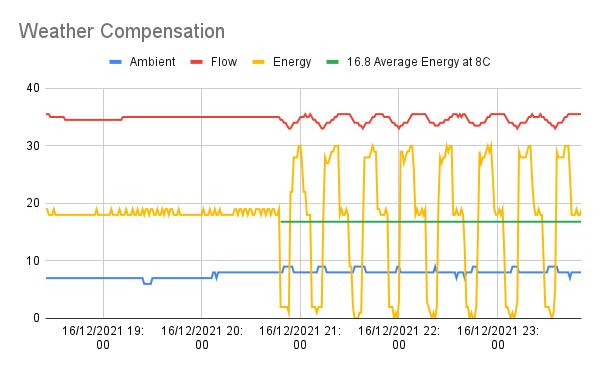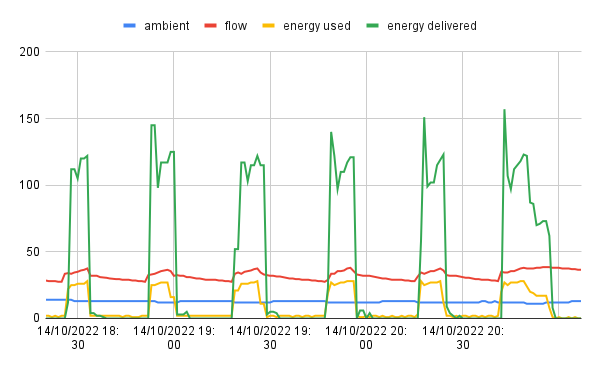
Kevm
Members-
Posts
52 -
Joined
-
Last visited
Personal Information
-
Location
Derbyshire
Recent Profile Visitors
The recent visitors block is disabled and is not being shown to other users.
Kevm's Achievements

Member (3/5)
6
Reputation
-
Heat pumps won’t work in old homes, warns Bosch
Kevm replied to Temp's topic in Air Source Heat Pumps (ASHP)
Because in most cases asking a gas fitter to install and commission a heat pump is like asking a tyre fitter to change an engine. -
Where does the 125 come from then?
-
From your link (my bold) "Efficiencies are determined based on respective CEN standards for boilers. All corrections F(i) relevant for boilers, e.g. due to auxiliary electricity consumption or due to standby loss, are negative. Different dedicated standards apply for determination of annual efficiencies of cogeneration devices and heat pumps. Additionally, for cogeneration devices one positive correction F(i) is applied due to electricity produced by the device itself. This makes it possible for a device to achieve efficiency exceeding 100%. A ‘conversion coefficient’ (CC=2.5) is used, reflecting the estimated 40% average EU generation efficiency referred to in Directive 2012/27/EU of the European Parliament and of the Council." It looks like they are trying to shoehorn boilers and ASHPs into the same labelling requirements. I suspect the 125 number is 100*SCOP/2.5. My ASHP has a SCOP in the low-mid 3s. I can measure COP quite accurately and the lowest daily average I have ever seen for heating (UK East Midlands) is about 2.75 and for HW 1.75. That's for radiators at 40-45 degrees flow. A
-
Weather Compensation Modelling and Actual results
Kevm replied to JamesPa's topic in Air Source Heat Pumps (ASHP)
thanks. One question. Once the heat demand is low and the flow is fixed and high (e.g. 55 deg) the ASHP will only be heating for a fraction of the day. In practical terms, it's going to be stopped and started by a thermostat throughout the day rather than be on for a single period. Do you think that the heating and cooling involved would add significantly to the power consumption? Based on my observations of my own system I'm not sure it would btw. -
Weather Compensation Modelling and Actual results
Kevm replied to JamesPa's topic in Air Source Heat Pumps (ASHP)
@JamesPa, thanks, this is really useful. Would you mind if I shared the link on another forum (renewableheatinghub.com)? There are folks there who would find this really useful. I would of course credit you with its creation. -
Weather Compensation Modelling and Actual results
Kevm replied to JamesPa's topic in Air Source Heat Pumps (ASHP)
Nice work. The results are similar to my own observed measurements. I was surprised it didn't make much difference then. I'll plug my numbers in later and see how it compares Some of the horror stories you hear are for higher flow temps, e.g 50 deg so the difference will be more. @JamesPa In answer to your question on the other thread, the data below is from my MMSP logs and is total ASHP electricity used including HW (I did say it was flawed!) and average outside temperature as recorded by the ASHP. HW use was very little. -
@JamesPa It is good at maintaining temperature but it will ramp up the LWT a lot (to 55 deg) to warm a cool house - if you let it. I'm limiting mine to 48 deg. I agree about the difference between WC and COP. I did some crude analysis comparing fixed 45 deg flow with WC and came up with this. Maybe a new topic to discuss all this might be better as the OP's thread has been hijacked a bit.
-
I never said it wasn't. My response was to JamesPa, who said "load compensation, adjusting for short term variations due eg to solar gain". I was just saying that from what I observed it was more than that. Mitsubishi is a bit vague on how it works but on another forum, a member asked their technical support and got an answer. Still a bit short on detail but suggests it's a bit more than weather and load compensation. It's probably not as cheap to run as me constantly tinkering with WC curves but for someone less well informed or interested, it's pretty good. Question: - My understanding of how Auto Adaptation should operate is that, the water temperature produced by the heat pump should follow the weather compensation curve, but if the indoor air temperature is below the desired temperature, the Auto Adaptation would add slightly to the weather compensation to gradual increase the water temperature, and hence increase the indoor air temperature. The reverse should occur if the indoor air temperature is too high. Could you please clarify if my assessment of the control philosophy is correct? Reply:- Good Afternoon, Yes your description of the Auto adaption mode is quite accurate. The controller will constantly monitor room temperature and vary the flow temperature depending on the outside ambient temperature and how far away the target temperature is from the actual room temperature. It also has a self-learning function which will follow similar patterns it adapted to in the past. For example, if 3 days previously the outdoor ambient was 5 degrees and the room stat was set to 22 degrees and the room was at 20 degrees, it will look at the flow temperature it used that day to get the room up to 22 degrees and adapt the flow temperature accordingly. If the room temperature does not increase over a 1 hour period it will increase flow temperature by 1 degree every hour until it reaches room target temperature.
-
It's definitely more than that. It bumps up the flow when the difference between set and actual room temp is a lot. It does this less when the difference is only a little. Some of the parameters that control this are adjustable. It also claims to have some 'learning' capability. It does because it behave differently in the first 2 or 3 days compared with now.
-
Mitsubishi has something called, 'auto adaptation'. It's based on WC but uses room temperature as a target using its own thermostat. No need for expensive add-ons, specialist knowledge or faffing around with WC curves. I'm trying it out at the moment and it seems to work well. I'm sure other manufacturers have similar technology. Or do they?
-
Heat Pump vs Gas Boiler: Relative Climate Impact
Kevm replied to Green Power's topic in Air Source Heat Pumps (ASHP)
@Green Power Thank you for this. Some of your assumptions may be open to debate but your analysis is very useful. I think it stands up well to the attempts to discredit it by disputing minor points and indulging in a bit of 'whataboutery'. -
Hmmm, the conflicting information on the Homely site puts me off right away. I think the key word here is 'compatible'. My £90 wireless stat is 'compatible' with my Ecodan in that it can connect to the controller and switch it on and off. Homely can work like a standard room stat too and I suspect that's what the long list of compatible manufacturers refers to. I think the clever integration is currently only Samsung and Midea.
-
Can you explain why a clamp meter doesn't work? I assume these meters measure current and then work out power from an assumed 240v?
-
If you want to see what cycling looks like here are some graphs from my 14kW Ecodan. The first pic is from last year and you can see as the outside temp reaches about 8 degrees, it starts cycling at about 3 x per hour. The Y axis scale for energy is joules per minute. The minimum the ASHP will use steady state (no cycling) is about 1.1kW so maybe 5kW delivered. The second picture is from yesterday. I now have my MMSP monitoring working so can show energy delivered. It was more like 14 degrees and the heating was barely needed (it's running on weather comp only and keeping my whole house at about 20 deg). The cycling is a bit less frequent, maybe 2x per hour. The COP for the 3 hours or so is 3.9 and it's delivering an average of 2.2kW.
-
These new Samsungs are quite chunky, 1270x1018x530 mm to be precise. That's a volume of 0.69m3. I don't know where you live but the limit for permitted development in England is 0.6m3. Having to apply for planning permission would put me right off.







